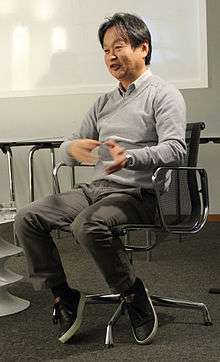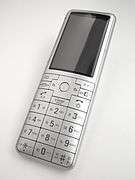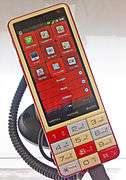Naoto Fukasawa
Naoto Fukasawa (深澤 直人) is a Japanese industrial designer, author, and educator.[1] Since 2014, he teaches Integrated Design at Tama Art University as a professor.[2] In 2003, he established Naoto Fukasawa Design.[3]

Biography
He was born in Kōfu, Yamanashi Prefecture, Japan in 1956. He graduated in 1980 from Tama Art University with a degree in product design.[2][4]
Fukasawa worked at IDEO in San Francisco, California and later helped establish the IDEO Tokyo office.[5] He established Naoto Fukasawa Design in 2003.[3] Since 2002, Fukasawa has been a MUJI advisory board member and worked on the development of many of their products. Representative works of Fukasawa include the "±0" brand of household electrical appliances and sundries. In recent years, he has released a host of new works with Italian companies B&B Italia, Driade, Magis, Artemide, Danese, and Boffi, as well as in Germany and Northern Europe, and they have garnered a great deal of attention.
As of 2012, he is one of the co-directors of 21 21 DESIGN SIGHT, Japan's first design museum.[6][7][8]
Fukasawa previously taught at Musashino Art University. Since 2014, he teaches Integrated Design at Tama Art University as a professor.[2]
Many of his works are included in the permanent collection at the Museum of Modern Art (MoMA) including, MUJI's Wall-mounted Compact Disc Player (1999), Neon Cellular Phone by KDDI Corporation (2005), and Infobar Cellular Phone by KDDI Corporation (2003).[9]
He has been described by Bloomberg Businessweek as one of the world's most influential designers.[10]
Select awards
In the past, he has won over fifty awards, including the American IDEA Gold Award, the German iF Gold Award, the British D&AD Gold Award, the Mainichi Design Award and the 5th Oribe Award.
- 1991 – IDEA Gold Award in the United States[11]
- 1994 – Red Dot award in Germany[12]
- 1996 – iF Gold Award in Germany[11]
- 2003 – Mainichi Design Prize
- 2005 – 5th Oribe Award
- 2014 – Good Design award in Japan[13]
- 2018 – Isamu Noguchi Award[14]
- D&AD Gold Award from the United Kingdom
Bibliography
- Fukasawa, Naoto (2018). Naoto Fukasawa: Embodiment. Phaidon Press. ISBN 9780714876078.
- Fukasawa, Naoto (2014). Naoto Fukasawa. Phaidon Press. ISBN 0714866032.
- Fukasawa, Naoto (2005). An Outline of Design. Japan: TOTO Shuppan.
- Fukasawa, Naoto; Goto, Takeshi; Sasak, Masato (2004). The Ecological Approach to Design. Japan: Tokyo Shosek.
Gallery
References
- "naoto fukasawa interview". designboom. 2004-04-18. Retrieved 2019-01-25.
- "Naoto Fukasawa, Lighting Designer Profile". www.lightology.com. Retrieved 2019-01-25.
- "Best Practice, Naoto Fukasawa, Product Design". Red Dot. Archived from the original on 2008-02-08. Retrieved 2019-01-24.
- "Antiques of the Future, Naoto Fukasawa". mydesignlife.com. Retrieved 2019-01-25.
- "DESIGN IN MIND: Naoto Fukasawa". Arkitektura Assembly. 2015-10-08. Retrieved 2019-01-25.
- "Art Space Tokyo". 21_21 Design Sight: Tokyo Art Maps. Retrieved 2012-01-09.
- Ashcraft, Brian (2007-05-01). "Without Thought". Metropolis. Archived from the original on 2007-10-05. Retrieved 2019-01-24.
- Prescott, Judith (2009-01-13). "Japanese design comes of age". RFI. Retrieved 2019-01-25.
- "Naoto Fukasawa | MoMA". The Museum of Modern Art. Retrieved 2019-01-25.
- "World's Most Influential Designers". Bloomberg.com. Archived from the original on 3 September 2012. Retrieved 2019-01-25.
- "Naoto Fukasawa Not Just Winning Awards--Now He's Designing Them". Core77. Retrieved 2019-01-25.
- "Naoto Fukasawa". www.awmagazin.de (in German). 2011-04-05. Retrieved 2019-01-25.
- "What Are the G-Mark and Good Design Award?". Core77. Retrieved 2019-01-25.
- "Industrial Designer Naoto Fukasawa on His Creative Process". Metropolis. 2018-03-19. Retrieved 2019-01-25.
External links
| Wikimedia Commons has media related to Naoto Fukasawa. |



